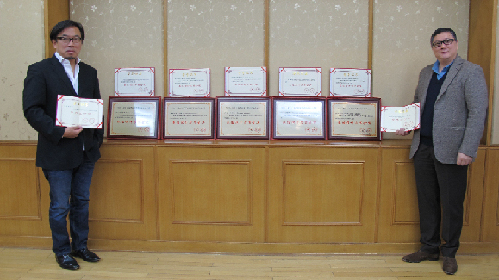Looking at China as an innovator, not an imitator
Updated: 2011-12-29 10:49
(chinaculture.org)
|
||||||||
When China opened its door to the world almost 30 years ago, its capital Beijing was made up of mostly small lanes, except for old-fashioned government buildings and uniform Russian style hotels. Israeli journalist Dan Ben-Canaan recalled his first visit to China in the early 1980s.
Three decades later, distinctive constructions like the Olympic Stadium, otherwise known as the Bird’s Nest, and the Dutch architect-designed China Central Television Tower were listed into The 10 Best Architectural Marvels globally in 2007 by Time Magazine, a world renowned US publication. Buildings like these are rising up day and night in bustling metropolises like Beijing and Shanghai, as China quickens its step to involve in the international community and make itself home to numbers of international architects.
When some argued that China has fallen into the trial range of outlandish buildings from foreign designers, Ken Wai and Andy Wen, veteran architects of Aedas, the No. 1 practice globally according to Building Design magazine's newest World Architecture 100 list of leading practices, which measures a practice's size by the number of architectural employees, thought differently.
 |
|
Ken Wai, Managing Director of Greater China of Aedas (Right) and Andy Wen, Executive Director of Aedas, showcase the five Best Design awards and two Excellent Architects honors after the award ceremony of China’s famed annual architecture competition on December 14. [Photo/chinaculture.org/Dong Lin] |
“The design of the glass pyramid entrance for the Louvre Museum by Chinese-American architect Leoh Ming Pei in the 1980s was once largely disputed, but it has turned out to be a landmark in Paris now”, said Wai, who added that time is the best test for controversial foreign conceptions.
“What tourists can remember, in most cases, are the contentious buildings in the place”, said Wen, who believes controversial constructions can reflect the local identity in a sense.
Zhang Zaiyuan, who holds a PhD from The University of Tokyo and is an internationally celebrated architect, agreed that the multi-cultural “trials” in architecture were inevitable and essential as China grew from a relatively secluded country to an embracing power. The ultimate way out for Chinese design depended on its carving out space for self-expression within cultural clashes.
China has come to realize the significance of learning from the advanced outside world and has unleashed the study-abroad rush ever since its defeat in the two Opium Wars — the climax of simmering disputes over trade and diplomatic relations between China under the reign of Qing Dynasty (1644-1911) and the British Empire — that happened between 1840 and 1860. After the founding of the People’s Republic of China, the adoption of reform and opening-up policy in 1978 spurred the learning-from-the-west wave.
Alice Rawsthorn, the design critic of the International Herald Tribune, the global edition of the New York Times, said in an interview with Chinese media that China’s system restructuring was first and foremost favorable toward broadening peoples’ minds and enriching its culture, but limited economic development in the 1980s hindered the realization of brilliant architectural conceptions. As China has accelerated the process in globalized networks in recent years, its buildings by domestic designers are showcasing much more distinctive features after decades of imitation and emulation of the western styles.
Born in Hong Kong and educated in architecture in London, Ken Wai returned to China to work over 10 years. His works have won a number of influential awards in China and globally.
“Using advanced international techniques and standards and incorporating Chinese traditions,” Ken Wai, Managing Director of Greater China of Aedas, said after the company collected five Best Design awards and two Excellent Architects honors, topping all other firms in China’s famed annual architecture competition on December 14. The competition aims at improving the Chinese living environment by praising brilliant design pieces from Chinese enterprises and international ones.
Wai’s project, Hangzhou Xiaoshan International Airport, is one of the five constructions to receive the Best Design award.
 |
|
The undulations and curves in the ceiling, which are formed by perforated aluminum strips, are meant to resemble flowing silk cloth in an effort to create an iconic area in the Hangzhou Xiaoshan International airport. [Provided to chinaculture.org] |
"The city of Hangzhou has both strong cultural heritage and poetic landscape,” it reads on Aedas’s website.
Considering the city’s heritage in the silk trade, Wai’s design concept was based on scrolls of silk sheltering the airport terminal. His objective was to create a place which represented the cultural heritage of the city with a balance of modernity in today’s China.
“The soft undulating forms line the main roof and exude a dynamic image to visitors at the departure and arrival halls,” the website continued.
Therefore, the silk concept was added, Wai explained.
The project captured the world-renowned Merit Award for Interior Architecture at the American Institute of Architects Hong Kong Design Awards 2010.
“I think I achieved my concept to build a modern airport inlaid with Chinese elements”, Wai said, explaining the reason his Chinese project won an American honor.
Wai’s case signifies that preserving traditions doesn’t mean duplicating history.
“Copying the physical form of Chinese ancient architectural styles — mainly those which are timber-structured — in modern designs is hardly possible”, said Andy Wen, Executive Director of Aedas, who believes showcasing the spirit of Chinese traditions tops its physical form.
Most notably in a day where peoples’ living needs and building functions have changed, it doesn’t work that way, Wai noted.
The stress of urban development throughout contemporary China requires a higher speed of construction and higher storey ratio, implicating why the demand for traditional Chinese structures has declined in favor of modern architecture.
Ancient Chinese buildings are constructed with wood to a large extent, while most modern structures are not; architecture from the past was, in most cases, one or two-stories high as opposed to the current skyscraper model, Wen explained.











